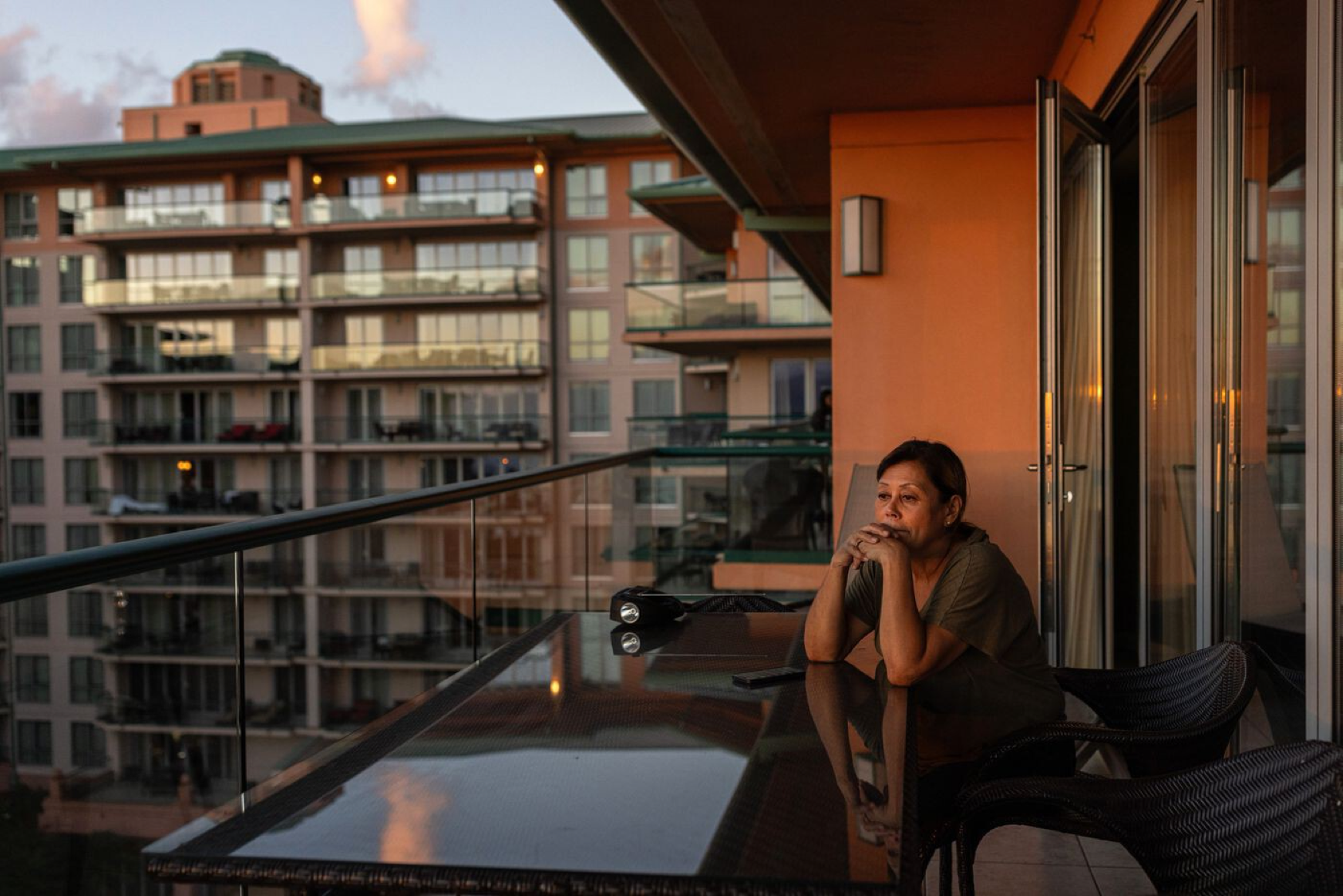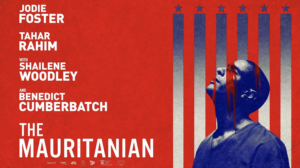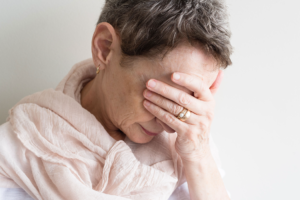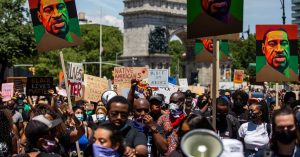As tourism returns to Maui, those displaced by this year’s deadly fires face losing their homes again.
Like many other families this August, Krizhna Bayudan, 23, a Lāhainā resident, recalls her family of six sleeping in their cars wondering whether their house, where she has lived her entire life, burned down in the fires that decimated West Maui. They would later learn that it was completely destroyed, along with every other house in their neighborhood. Her family relocated at least five times within the first few weeks before being placed at a hotel-condominium in Kāʻanapali. “It’s so nice to just see people we used to see … and knowing that they’re okay,” Bayudan said, describing walking the hotel’s hall, which has become a collective space for many other displaced families.
Just one month after the deadliest wildfires in US history ravaged West Maui — killing at least 97 people, displacing thousands, and incinerating the historic town of Lāhainā — Hawaii’s governor announced that the island would fully reopen to tourism. Beginning October 8, travel restrictions will be lifted and visitors will be welcome to resume their vacations.
The reopening means that families like Bayudan’s face yet another displacement from hotels as they prepare to make room for tourists who will soon lodge in the same rooms that have been used as emergency housing. This moment underscores historic tensions between tourism and local residents and Hawaiians: Maui’s economy depends on tourism, yet the visitor industry is making it increasingly unlivable for those who call it home. Now, with a reopening for tourists being framed by their governor as a welcome return to normalcy, many locals feel the opposite as they navigate what they see as a housing crisis within the climate crisis.
Bayudan and her family have been told by the American Red Cross, which operates the hotel for fire survivors, that they would have lodging there until October 31, which was later confirmed via email by the resort’s management company. But she joins many other displaced residents in their fear of the unknown. She’s heard that the date could be extended, but if not, she has no idea where her family will move next. While living in the hotel has given her and her family some much-needed relief, the uncertainty around when they would need to relocate has made it impossible for them to feel settled and safe. Bayudan told Vox that her family is still in danger of being relocated well before that date if the rental owners decide that they want to come back to Maui.
“I just want a final answer already,” she said. Until then, she will continue living out of her suitcase.
Hawaii Gov. Josh Green’s administration, along with the Hawaii Tourism Authority, is imploring visitors to return to spend money at the island’s hotels, restaurants, retail shops, and visitor experiences in order to support its economic recovery. “We have to just begin to heal,” Green said during a recent news conference at the state capitol in Honolulu, on Oahu.
After survivors spent weeks sleeping in gymnasiums, church halls, in their cars, and on the beach, nearly 8,000 people are currently sheltering across 40 Maui hotels. Many of them are employed in the visitor industry, some at the very hotels where they’re staying. A majority of them are in impacted West Maui, which hosts over 50 percent of the entire island’s lodging capacity.
“As we continue care of those displaced, we may look to consolidate or shrink our footprint across hotels,” said the American Red Cross in a statement to Vox. “During this process, some people may need to be relocated to different hotel properties. However, we will communicate all changes with our residents and do our best to ensure the least amount of disruption as possible.”
Veronica Mendoza Jachowski, co-founder of Roots Reborn Lāhainā, a group of Maui-based immigration lawyers and community organizers, is currently providing direct emergency needs assessment to Latino immigrants, including undocumented survivors. She said the uncertainty is already doing the work of forcing some community members out. “They’re leaving the hotels and now paying rent,” she said. “They’re not even two months out, and they’re already hustling to make ends meet so that they can pay rent.”
For some, the October 8 reopening signifies a rushed return
Gov. Green and the American Red Cross have assured that those who qualify for housing assistance will not be kicked out of the hotels without alternative accommodation. The reopening has nonetheless stoked fears of further displacement and reignited outrage from state residents over whom their home ultimately caters to, and how much longer it can sustain that servitude. Some survivors have already reported receiving notices from their hotels asking them to vacate. Others remain on edge, fearing that it’s only a matter of time before they receive their own notices.
At the end of September, the state’s Safe Harbor program ended, threatening more than 600 disaster survivors with displacement if they did not register to remain in temporary housing by that date or could not show proof of residence, Hawaii News Now reported. Some survivors, including those who were unsheltered before the fires, will now be transferred back into a temporary shelter setting.
Those who don’t face relocation still fear that it’s too soon to return to normal. “There is this forced attempt to make the October 8 reopening feel happy and cheery and inevitable,” said Khara Jabola-Carolus, a former state official now volunteering primarily for Tagnawa, an immigrant group organized in the wake of the fire. Tagnawa provides a working-class Filipino response for the Filipino immigrants who make up roughly 40 percent of Lāhainā’s community.
Interacting directly with those impacted, she has heard “the spectrum” of responses to the reopening, but none of them have been eager. “It’s this looming date that everyone is dreading,” she said.
“Some people [say], ‘Well, we know that it’s good for the rest of the island, so we’re willing to take it for the rest of Maui because we don’t want to hurt our friends,’” Jabola-Carolus added. “What I saw more of, personally, were people erupting into tears and talking about how sad it was making them.”
Healing, many survivors believe, is the last thing the reopening will bring.
A petition by community group Lāhainā Strong to delay the reopening garnered more than 3,000 signatures within the first 24 hours — rebuking the governor’s argument of widespread support.
“A couple of people said that we didn’t get input,” Green told Hawaii News Now’s Spotlight Now. “That is not true. We held a meeting with 200 individuals who had either lost their home or their boat or their business or, God forbid, one of their loved ones. They told us almost unanimously — I mean, like well into beyond 90 percent — that they had to reopen.”
In contrast, as of October 6, the petition stands at over 16,000 signatures.
Maui’s complex dependency on tourism
Less than a week after the fires, Pā’ele Kiakona, 28, who is a part of Lāhainā Strong, was standing with local news channel KITV’s Jeremy Lee at the Lāhainā bypass connecting to Kāʻanapali. He grew up in Lāhainā, and his grandmother’s house on Front Street, which was incinerated by the fires, had housed seven generations of his family. He was sharing how the community had lost everything — including loved ones — when they were repeatedly interrupted mid-interview by people taking photos and gawking at the devastation.
Kiakona has no reason to believe that tourists returning to Maui when it fully reopens will be any more respectful. “The only type of people who are going to come to a disaster zone for vacation are going to be those very disrespectful types of people [who] are insensitive and don’t care,” he said.
Tourists to Hawaii are notoriously misbehaved, so much so that in 2019, the Hawaii Tourism Authority launched a marketing campaign to gently but explicitly educate visitors on appropriate behavior. Then the pandemic hit, slingshotting the state economy back into complete codependency on its most lucrative economic driver. Tourism is the state’s largest employer and remains Hawaii’s largest single source of private capital. And while the pandemic sparked earnest conversations around diversifying the state’s economy, they fizzled as soon as tourists returned.
After being urged to steer clear following the fires, state officials are now asking tourists to return to help the island recover, recently approving a $2.6 million marketing budget to court travel back to Maui. Tourism accounts for 80 percent of the county’s income. “Every 1,000 units not rented to tourists translates to a potential $30M monthly loss for local businesses, suggesting a prolonged recovery for our workforce,” read a report from the University of Hawaii Economic Research Organization (UHERO) on Maui’s long journey to recovery.
“I can’t control people’s behavior,” said Green in a recent press conference. “The appeal I’m making to everyone is ‘Come and help us heal.’”
Those from Lāhainā’s immigrant communities especially, who have uneven access to financial aid, are not waiting for the state government and Red Cross to coordinate housing for the next 18 months as the governor had repeatedly promised. Community organizations like Roots Reborn say that some displaced families have already left the island for the US continent.
Many now fear that further displacement will make way for a land grab.
Maui’s housing crisis, explained
Top officials — from Gov. Green to President Biden — have assured the people of Lāhainā that the town will be rebuilt the way the community wants, assuaging early fears that the fires just paved the way for the island’s total gentrification.
Destroyed homes will need to be rebuilt in the most expensive housing market in the nation: Median housing costs in Hawaii are reportedly 214 percent higher than the national average. Less than a third of Hawaii residents can afford to buy a single-family home, according to another UHERO study. For many, the opportunity to be a homeowner is dependent on whether they inherit a house or can sustain multiple jobs.
Consequently, 40 percent of Hawaii households are renters, who on average spend over 40 percent of their income on housing.
The Hawaiian Home Lands program, created by the US Congress in 1921 to return Native Hawaiians to the land by awarding homestead lots, today has a generations-long waitlist of some 30,000 people on some islands. Many have died before getting off the waitlist.
Reasons behind the housing crisis are manifold, not least among them because much of the current housing stock is vacation rentals, motivated in part by the state having the lowest property taxes in the nation.
Nearly a quarter of home purchases statewide are made by out-of-state buyers; on Maui, more than 70 percent of homes purchased in 2020 went to vacation homes or rental investments.
With neighboring islands faring no better, local families have been migrating to other states in search of affordable housing.
For the first time, Native Hawaiians living on the continent outnumber those who live in their homeland.
At least 2,200 buildings were damaged or destroyed by the fires, and nearly all of them were residential. Many of the houses in the burn zone reportedly also had been in the hands of local families for generations — including Kiakona’s grandmother’s home.
“When the fire happened, the first thing that came to my mind was people are going to leave their homes and they’re going to start selling their property,” said Kiakona. “And corporate interests, with their greed, are going to … try and take advantage of people in their times of need.”
Amid immediate reports of unsolicited offers to buy land for cash by “vulture agents,” the governor voiced his commitment to protecting affected residents. “You would be pretty poorly informed if you try to steal land from our people and then build here,” he said.
But the devastated and wary community isn’t exempting the government from making its own play for land.
Gov. Green extensively cited housing challenges for Native Hawaiians especially in his emergency proclamation on housing in July, which introduced a fast-tracked process for housing projects that would bypass regulatory barriers, including cultural and environmental reviews and public transparency in government meetings. It didn’t take long for the governor’s proclamation to attract strong criticism and, following the fires, litigation. In September, after considerable public pressure, the governor amended the proclamation to reinstate those regulations, but litigation remains ongoing.
While few can deny that a housing crisis exists, many debate whether the crisis actually stems from a housing shortage. More than 2,000 housing units were secured to shelter the displaced within the first two weeks after the fire, according to the governor.
“Is Hawaii’s shortage of affordable housing really a supply issue, where the constitution has to be suspended so that more can be built,” said Maui attorney Lance Collins, who filed one of the two lawsuits targeting the proclamation. “Or, is it a distribution issue?” He believes it would be more impactful to defer mortgage payments, which is why he is petitioning the governor for mortgage deferral for Lāhainā residents for three years.
“Almost every home in the burnout zone had a mortgage on it,” Collins said. “If there isn’t a general deferment process that everybody can use while they’re rebuilding, six [to] nine months from now, there’s going to be a tsunami of foreclosures, and then there is going to be a land grab.”
“I don’t think it has anything to do with having enough homes,” said Kiakona. “[It] has everything to do with mismanaging what we have.”
Gov. Green again cited fear of “mass exodus” as a driver behind reopening, stating at the recent press conference that workers “passionately” supported the reopening to support their ability to continue to live there.
Much of that anxiety is extended to their current shelter. “It’s a thing across the hotels,” said Jabola-Carolus. “Even if you’re staying there as a disaster victim, you’re still working.”
Kiakona’s fear for those returning to work is that visitors will provoke more harm than healing. “It’s bound to happen,” he said. “People are going to ask, ‘Did you lose your home?’ That’s going to be a conversation that they’re going to have to repeat over and over again. And they never even got a chance to deal with how that made them feel.”
Rather than equate economic recovery to healing, Kiakona said, “the focus should be on how we’re going to get the money so the people here can focus on what’s really important. I don’t understand why [reopening] is the only option.”
“We’ve lost so much already”
Meanwhile, there are still loved ones who remain unaccounted for. A joint list as of September 29 from the FBI and Maui Police Department (MPD) puts the number of missing at 12, but that number only accounts for those with an official missing person’s report.
Some Maui nonprofit health care providers warned that interactions with incoming tourists could provoke altercations or trigger survivors.
So far, the governor remains committed to the October 8 reopening date.
When asked if community members have even begun to grieve their loss, Kiakona said that some are only recently able to admit that they’re not okay, eight weeks after the fire. Still, they don’t feel that they can afford to let up on pressuring the governor to reconsider. He and other community members remain in fight mode.
“It’s just hard,” said Kiakona. “We’ve lost so much already, and I don’t want to lose any more people. We don’t need any more hurt and pain to come to us right now.”




